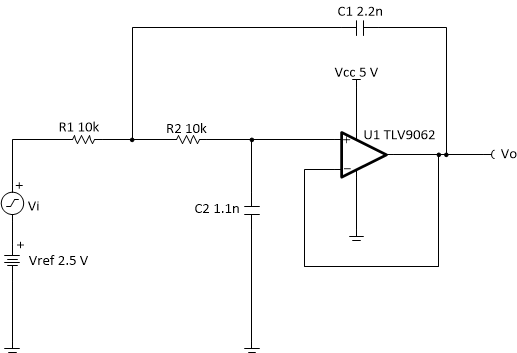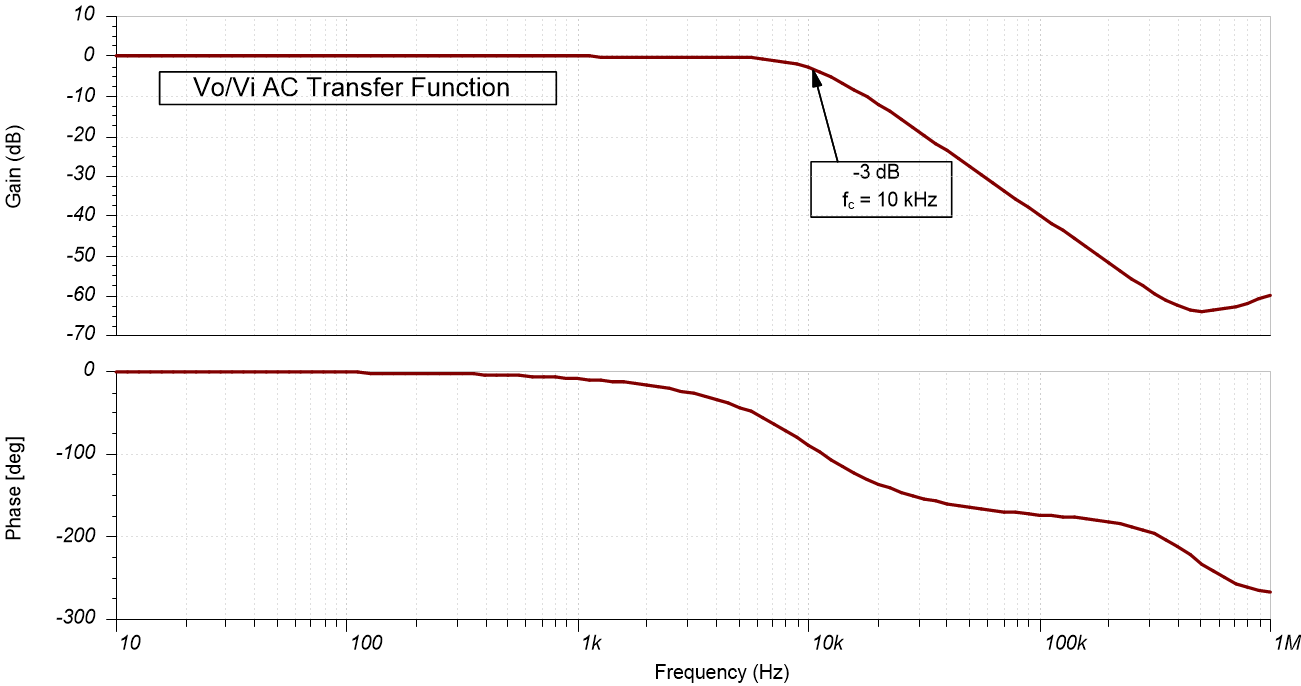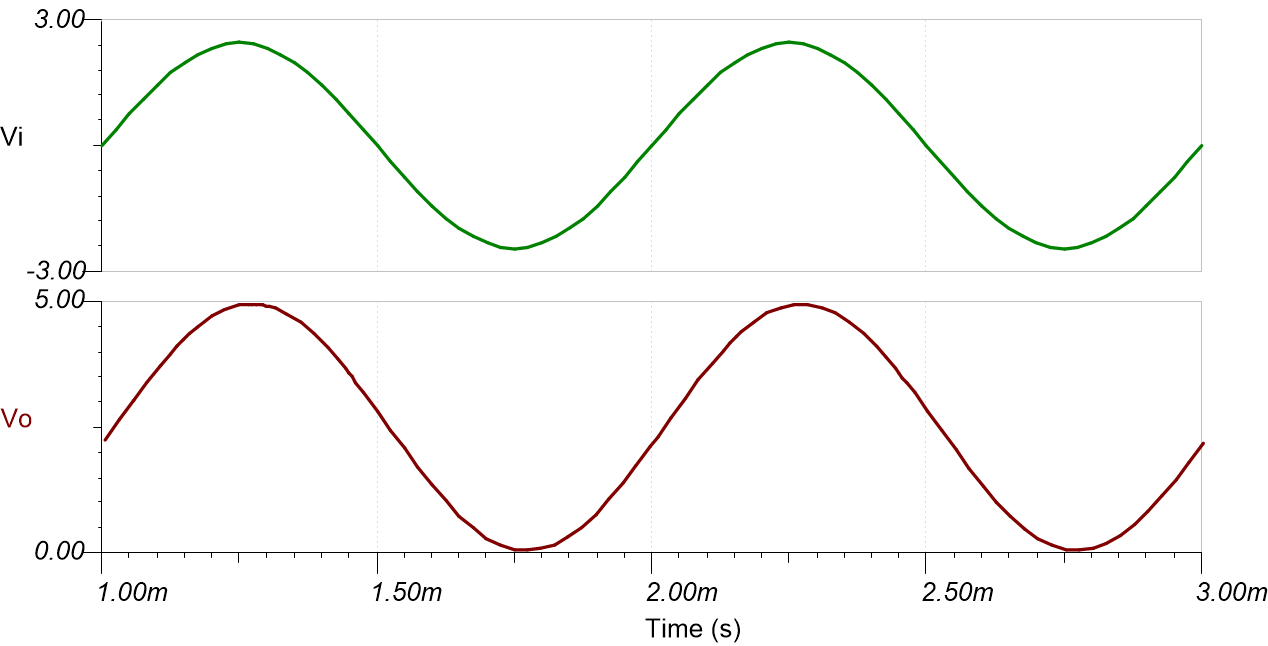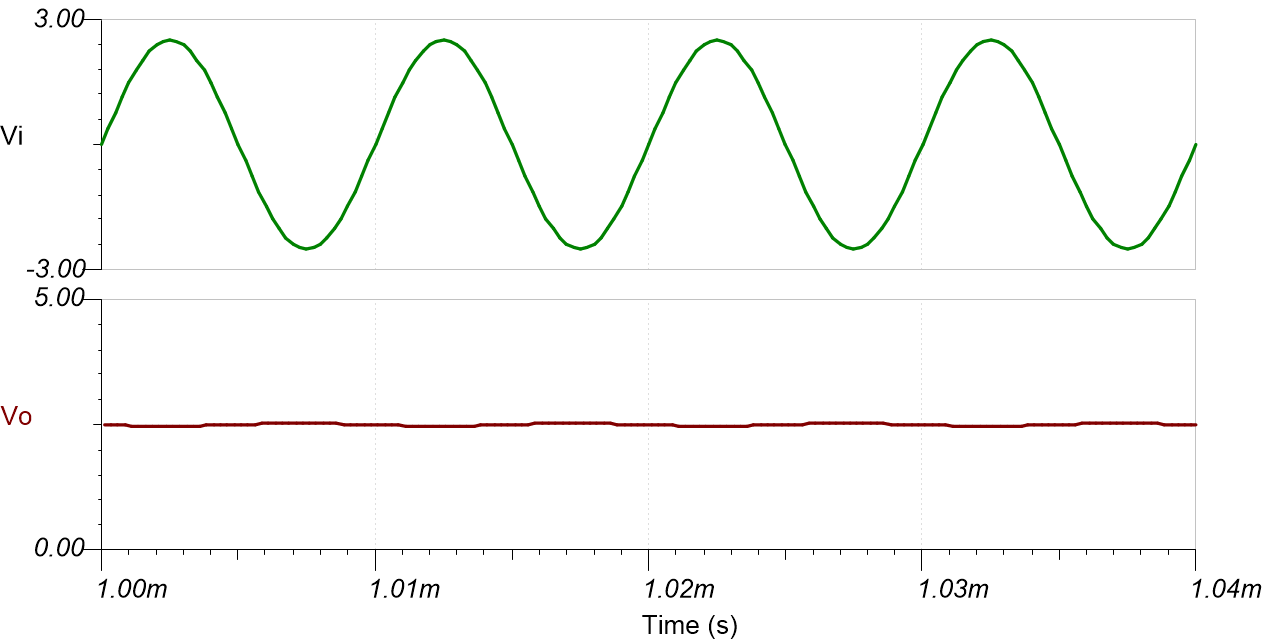-
Single-supply, 2nd-order, Sallen-Key low-passfilter circuit
Single-supply, 2nd-order, Sallen-Key low-passfilter circuit
| Input | Output | Supply | |||
|---|---|---|---|---|---|
| ViMin | ViMax | VoMin | VoMax | Vcc | Vee |
| –2.45V | +2.45V | 0.05V | 4.95V | 5V | 0V |
| Gain | Cutoff Frequency (fc) | Vref |
|---|---|---|
| 1V/V | 10kHz | 2.5V |
Design Description
The Butterworth Sallen-Key low-pass filter is a second-order active filter. Vref provides a DC offset to accommodate for single-supply applications. A Sallen-Key filter is usually preferred when small Q factor is desired, noise rejection is prioritized, and when a non-inverting gain of the filter stage is required. The Butterworth topology provides a maximally flat gain in the pass band.

Design Notes
- Select an op amp with sufficient input common-mode range and output voltage swing.
- Add Vref to bias the input signal to meet the input common-mode range and output voltage swing.
- Select the capacitor values first since standard capacitor values are more coarsely subdivided than the resistor values. Use high-precision, low-drift capacitor values to avoid errors in fc.
- To minimize the amount of slew-induced distortion, select an op amp with sufficient slew rate (SR).
Design Steps
The first step is to find component values for the normalized cutoff frequency of 1 radian/second. In the second step the cutoff frequency is scaled to the desired cutoff frequency with scaled component values.
The transfer function for second order Sallen-Key low-pass filter is given by:
Here,
- Set normalized values of
R1 and R2 (R1n and R2n) and
calculate normalized values of C1 and C2
(C1n and C2n) by setting wc to 1
radian/sec (or fc = 1 / (2 × π) Hz). For the second-order
Butterworth filter, (see the Butterworth Filter Table in the Active Low-Pass Filter Design Application Report).
- Scale the component values and
cutoff frequency. The resistor values are very small and capacitors values
are unrealistic, hence these have to be scaled. The cutoff frequency is
scaled from 1 radian/sec to w0. If m is assumed to be the
scaling factor, increase the resistors by m times, then the capacitor
values have to decrease by 1/m times to keep the same cutoff
frequency of 1 radian/sec. If the cutoff frequency is scaled to be
w0, then the capacitor values have to be decreased by 1 /
wo. The component values for the design goals are calculated
in steps 3 and 4. Equation 1.Equation 2.Equation 3.
- Set R1 and R2
values:Equation 4.Equation 5.
- Calculate C1 and C2 based on m and
w0.
- Calculate the minimum required
GBW and SR for fc.
The TLV9062 device has a GBW of 10MHz and SR of 6.5V/µs, so the requirements are met.
Design Simulations
AC Simulation Results

Transient Simulation Results
The following image shows the filter output in response to 5-Vpp, 1-kHz input signal (gain = 1V / V).

The following image shows the filter output in response to 5-Vpp, 100-kHz input signal (gain = 0.01 V/V).

Design References
- See Analog Engineer's Circuit Cookbooks for TI's comprehensive circuit library.
- SPICE Simulation File SBOC598.
- TI Precision Labs.
- Active Low-Pass Filter Design Application Report
Design Featured Op Amp
| TLV9062 | |
|---|---|
| Vss | 1.8V to 5.5V |
| VinCM | Rail-to-Rail |
| Vout | Rail-to-Rail |
| Vos | 0.3mV |
| Iq | 538µA |
| Ib | 0.5pA |
| UGBW | 10MHz |
| SR | 6.5V/µs |
| #Channels | 1, 2, 4 |
| www.ti.com/product/TLV9062 | |
Design Alternate Op Amp
| TLV316 | OPA325 | |
|---|---|---|
| Vss | 1.8V to 5.5V | 2.2V to 5.5V |
| VinCM | Rail-to-Rail | Rail-to-Rail |
| Vout | Rail-to-Rail | Rail-to-Rail |
| Vos | 0.75mV | 0.150mV |
| Iq | 400µA | 650µA |
| Ib | 10pA | 0.2pA |
| UGBW | 10MHz | 10MHz |
| SR | 6V/µs | 5V/µs |
| #Channels | 1, 2, 4 | 1, 2, 4 |
| www.ti.com/product/TLV316 | www.ti.com/product/OPA325 |
IMPORTANT NOTICE AND DISCLAIMER
| TI PROVIDES TECHNICAL AND RELIABILITY DATA (INCLUDING DATASHEETS), DESIGN RESOURCES (INCLUDING REFERENCE DESIGNS), APPLICATION OR OTHER DESIGN ADVICE, WEB TOOLS, SAFETY INFORMATION, AND OTHER RESOURCES “AS IS” AND WITH ALL FAULTS, AND DISCLAIMS ALL WARRANTIES, EXPRESS AND IMPLIED, INCLUDING WITHOUT LIMITATION ANY IMPLIED WARRANTIES OF MERCHANTABILITY, FITNESS FOR A PARTICULAR PURPOSE OR NON-INFRINGEMENT OF THIRD PARTY INTELLECTUAL PROPERTY RIGHTS. |
| These resources are intended for skilled developers designing with TI products. You are solely responsible for (1) selecting the appropriate TI products for your application, (2) designing, validating and testing your application, and (3) ensuring your application meets applicable standards, and any other safety, security, or other requirements. These resources are subject to change without notice. TI grants you permission to use these resources only for development of an application that uses the TI products described in the resource. Other reproduction and display of these resources is prohibited. No license is granted to any other TI intellectual property right or to any third party intellectual property right. TI disclaims responsibility for, and you will fully indemnify TI and its representatives against, any claims, damages, costs, losses, and liabilities arising out of your use of these resources. |
| TI’s products are provided subject to TI’s Terms of Sale (www.ti.com/legal/termsofsale.html) or other applicable terms available either on ti.com or provided in conjunction with such TI products. TI’s provision of these resources does not expand or otherwise alter TI’s applicable warranties or warranty disclaimers for TI products. |
| Mailing Address: Texas Instruments, Post Office Box 655303, Dallas, Texas 75265
Copyright © 2020, Texas Instruments Incorporated |